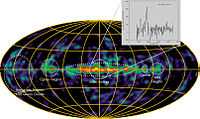Aluminium-26
| Aluminium-26 | |
|---|---|
| General | |
| Name, symbol | Aluminium-26,26Al |
| Neutrons | 13 |
| Protons | 13 |
| Nuclide data | |
| Natural abundance | trace (cosmogenic) |
| Half-life | 7.17×105 years |
| Spin | 5+ |
| Decay mode | Decay energy |
| β+, γ, x-rays | γ 1.808,[1] MeV |
| ε | fill in, please MeV |
Aluminium-26, 26Al, is a radioactive isotope of the chemical element aluminium, decaying by either of the modes beta-plus or electron capture, both resulting in the stable nuclide magnesium-26. The half-life of 26Al is 7.17×105 years. This is far too short for the isotope to survive to the present, but a small amount of the nuclide is produced by collisions of argon atoms with cosmic ray protons.
Aluminium-26 also emits gamma rays and X-rays,[2] and is one of the few radionuclides to emit X-rays. Because it is radioactive it should be stored behind at least 5 cm (2 in) of lead and special tools should be used for transfer, use, and storage. Contact with 26Al may result in radiological contamination.[3]
Dating of meteorites
Aluminium-26 can be used to calculate the terrestrial age of meteorites. After the breakup of the meteorite parent body, it will be bombarded by cosmic rays, which will saturate it in aluminium-26. After falling to earth, 26Al production ceases, which means that the amount of 26Al in the sample can be used to calculate the date the meteorite fell to earth.
Occurrence in the interstellar medium

The gamma emission at 1809 keV was the first observed gamma emission from the galactic center. The observation was made by the HEAO-3 satellite in 1984.[4][5]
The isotope is mainly produced in supernovae ejecting many radioactive nuclides in the interstellar medium. The isotope is believed to provide enough heat to small planetary bodies so as to differentiate their interiors, such as has been the case in the early history of the asteroids 1 Ceres and 4 Vesta.[6][7][8] This isotope also features in hypotheses regarding the equatorial bulge of Saturn's moon Iapetus.[9]
History
Before 1954, the measured half-life of aluminium-26 was determined to be 6.3 seconds.[10] After theoretical evidence occurred that this could be the half-life of a metastable state (isomer) of aluminium-26, the ground state was produced by bombardment of magnesium-26 and magnesium-25 with deuterons in the cyclotron of the University of Pittsburgh.[11] The first half-life was determined to be in the range of 106 years. The Fermi beta decay half-life of the aluminium-26 metastable state is of interest in the experimental testing of two components of the standard model, namely, the conserved-vector-current hypothesis and the required unitarity of the Cabibbo-Kobayashi-Maskawa matrix.[12] The decay is superallowed. The 2011 measurement of the half life of Al-26(m) is 6346.54 ± 0.46(statistical) ± 0.60(system) milliseconds.[13]
See also
References
- ↑ Thomas, J. H.; Rau, R. L.; Skelton, R. T.; Kavanagh, "Half-life of 26Al" R. W. Physical Review C (Nuclear Physics), Volume 30, Issue 1, July 1984, pp.385-387.
- ↑ "Nuclide Safety Data Sheet Aluminum-26" (PDF). www.nchps.org.
- ↑ "Nuclide Safety Data Sheet Aluminum-26" (PDF). National Health& Physics Society. Retrieved 2009-04-13.
- ↑ Mahoney, W. A.; Ling, J. C.; Wheaton, W. A.; Jacobson, A. S. (1984). "HEAO 3 discovery of Al-26 in the interstellar medium". The Astrophysical Journal 286: 578. Bibcode:1984ApJ...286..578M. doi:10.1086/162632.
- ↑ Kohman, T. P. (1997). "Aluminum-26: A nuclide for all seasons". Journal of Radioanalytical and Nuclear Chemistry 219 (2): 165. doi:10.1007/BF02038496.
- ↑ Moskovitz, Nicholas; Gaidos, Eric (2011). "Differentiation of planetesimals and the thermal consequences of melt migration". Meteoritics & Planetary Science 46 (6): 903–918. arXiv:1101.4165. Bibcode:2011M&PS...46..903M. doi:10.1111/j.1945-5100.2011.01201.x.
- ↑ Zolotov, M. Yu. (2009). "On the Composition and Differentiation of Ceres". Icarus 204 (1): 183–193. Bibcode:2009Icar..204..183Z. doi:10.1016/j.icarus.2009.06.011.
- ↑ Zuber, Maria T.; McSween, Harry Y.; Binzel, Richard P.; Elkins-Tanton, Linda T.; Konopliv, Alexander S.; Pieters, Carle M.; Smith, David E. (2011). "Origin, Internal Structure and Evolution of 4 Vesta". Space Science Reviews 163 (1–4): 77–93. Bibcode:2011SSRv..163...77Z. doi:10.1007/s11214-011-9806-8.
- ↑ Kerr, Richard A. (2006-01-06). "How Saturn's Icy Moons Get a (Geologic) Life". Science 311 (5757): 29. doi:10.1126/science.311.5757.29. PMID 16400121.
- ↑ Hollander, J. M.; Perlman, I.; Seaborg, G. T. (1953). "Table of Isotopes". Reviews of Modern Physics 25 (2): 469–651. Bibcode:1953RvMP...25..469H. doi:10.1103/RevModPhys.25.469.
- ↑ Simanton, James R.; Rightmire, Robert A.; Long, Alton L.; Kohman, Truman P. (1954). "Long-Lived Radioactive Aluminum 26". Physical Reviews 96 (6): 1711–1712. doi:10.1103/PhysRev.96.1711.
- ↑ Scott, RJ; O'Keefe, GJ, Thompson, MN; Rassool, RP, "Precise measurement of the half-life of the Fermi beta decay of (26)Al(m)," PHYSICAL REVIEW C Volume: 84 Issue: 2 Article Number: 024611, DOI: 10.1103/PhysRevC.84.024611 AUG 22 2011.
- ↑ Finlay, P et al, "High-Precision Half-Life Measurement for the Superallowed beta(+) Emitter (26)Al(m)", Phys. Rev. Lett., 106 Issue: 3 Article Number: 032501 (DOI: 10.1103/PhysRevLett.106.032501) JAN 21 2011